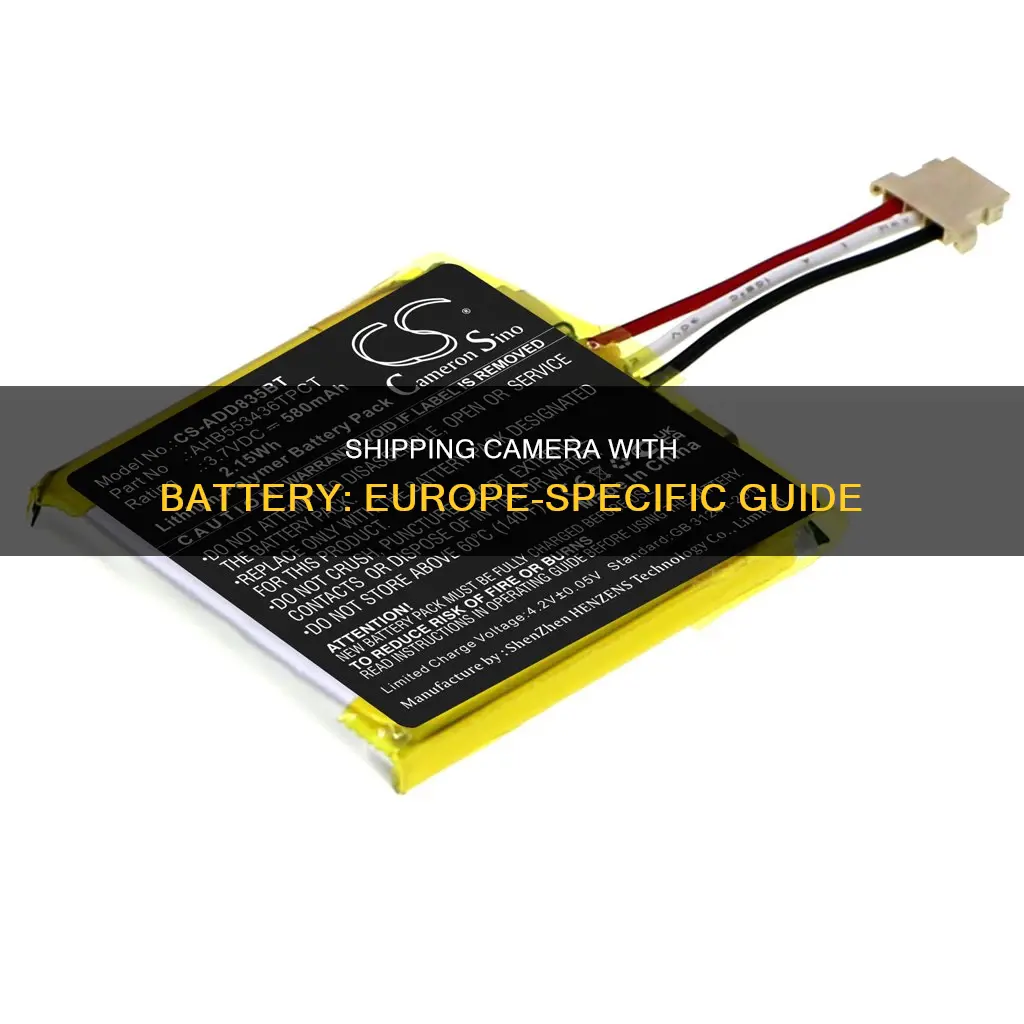
Shipping a camera with a lithium battery in Europe requires careful adherence to safety guidelines. Lithium batteries are considered dangerous goods due to their potential to overheat and ignite, hence the need for proper precautions when shipping them. When shipping a camera with a lithium battery, it is essential to keep the battery inside the camera to prevent static electricity or overheating. Additionally, the camera should be wrapped in bubble wrap and placed inside its case for extra protection. The packaged camera can then be placed in a sturdy cardboard box with the necessary markings, such as Lithium-ion battery or Handle with care. It is also important to secure any buttons to prevent accidental activation during transit and ensure the battery is not fully charged, with an optimal charge of up to 30%. These precautions help ensure the safe transport of cameras with lithium batteries within Europe.
| Characteristics | Values |
|---|---|
| Lithium batteries | Considered dangerous goods due to their potential to overheat and ignite |
| Shipping options | Ground service such as transport by road is the safest option; shipping by sea is also secure but requires robust packaging; air freight is suitable for electronics with lower battery capacities |
| Packaging | Should be strong and rigid, able to withstand shocks and mechanical handling; inner and outer packaging should be used to protect against scratching and static energy |
| Marking and labelling | Required to indicate the presence of lithium batteries and any relevant handling instructions |
| Battery charge | Should be no more than 30% |
| Shipping internationally | Requires compliance with applicable regulations to ensure the safety of personnel and craft |
What You'll Learn

Lithium batteries are classified as dangerous goods
Lithium-ion batteries are the newer technology of the two and are rechargeable. They are found in smartphones, tablets, and laptops. Despite their stability and safety compared to lithium metal batteries, they still pose a significant risk. Lithium-ion batteries have been blamed for several aircraft disasters due to their propensity to catch fire during flights. These fires usually occur when the batteries short circuit, and the resulting blaze can be challenging to control.
Lithium metal batteries, on the other hand, are typically non-rechargeable and contain metallic lithium. They are used in items such as watches, calculators, cameras, and car key fobs. While they have a higher energy density than similar non-rechargeable batteries, they also carry risks. If the internal circuitry of a lithium metal battery is compromised, it can lead to "thermal runaway". This means that the internal temperature of the battery increases, causing it to vent hot gases and ignite neighbouring cells, ultimately leading to a fire.
The dangers associated with lithium batteries have led to strict regulations for their packaging and transportation. These regulations are governed by organisations such as the International Air Transport Association (IATA) and outlined in manuals such as the Lithium Battery Shipping Regulations. The applicable regulatory requirements must be met to ensure the safety of personnel, aircraft, and passengers.
The process of shipping lithium batteries involves adhering to specific guidelines, such as ensuring that the cells and battery types have passed the relevant UN tests, protecting all terminals against short circuits, meeting packaging limits, and using appropriate inner and outer packaging. Additionally, the packages must bear the required marks and labels, and the necessary documentation must be completed.
The consequences of failing to comply with these regulations can be severe, including significant fines and even jail sentences for individuals within the organisation responsible for the shipment. Therefore, it is crucial to select appropriate packaging and work with a packaging supplier well-versed in these requirements.
Charging Camera Batteries: Strategies for Dead Rising Players
You may want to see also

Shipping lithium batteries by ground is the safest option
When shipping a camera with a lithium battery in Europe, it is important to follow the necessary precautions to ensure safe delivery. Shipping lithium batteries by ground is the safest option, and there are specific guidelines to adhere to. Firstly, it is recommended to remove the battery from the camera unless it is a lithium-ion battery, which must stay inside. This is because there is a risk of static electricity or overheating during transport if the battery is left inside, which could damage the camera and the battery itself.
When preparing the camera for shipping, start by not removing the body cap. The mirror and sensor in the camera are extremely sensitive, so the body cap provides essential protection. Next, remove any memory cards, straps, and flashes. Wrap the camera in 2-3 layers of bubble wrap and secure it with packing tape. If the camera has a case, place the wrapped camera inside for extra protection. Then, place the packaged camera inside a sturdy cardboard box and fill any empty spaces with packing peanuts or crumpled paper to prevent movement.
It is crucial to properly label the package when shipping lithium batteries. The box should have markings indicating that it contains a lithium-ion battery and must be shipped via ground only. These markings are important for safety and to ensure compliance with shipping regulations. Double-boxing is recommended for added protection. Place the boxed camera inside a larger sturdy cardboard box and fill any gaps with packing materials. Seal the outer box securely with strong packing tape, including the corners and edges.
Shipping lithium batteries by ground is the preferred method to ensure the safety of the shipment. By following the recommended packing and labelling procedures, you can help protect the camera and battery during transport and comply with shipping regulations.
Choosing the Right Charger for Your Camera: A Guide
You may want to see also

Packaging requirements for lithium batteries
When shipping a camera with a lithium-ion battery in Europe, it's important to follow the packaging requirements specific to these batteries to ensure safety and compliance with regulations. Here are some detailed instructions on the packaging requirements for lithium-ion batteries:
Inner Packaging
The inner packaging must completely enclose each battery or cell, preventing any contact with other equipment or conductive materials. Non-metallic inner packaging is generally required, and materials like plastic anti-static bags can be used. This inner packaging is then placed inside a sturdy outer container.
Outer Packaging
The outer packaging must be strong and rigid, capable of withstanding a 1.2-meter drop test without damaging the contents. It should also be designed to prevent the movement of batteries within and accidental activation of the equipment. Suitable outer packaging materials include metal, wooden, fiberboard, or solid plastic boxes; metal, wooden, or plastic drums; and metal or plastic jerrycans.
Weight and Quantity Limits
The weight and quantity of the batteries play a role in the packaging requirements. Typically, the overall gross weight of the package cannot exceed 30 kg. If the batteries weigh more than 26.5 pounds and have a strong, impact-resistant outer casing, they may be packed in strong outer packaging or protective enclosure casings like fully enclosed or wooden slatted crates.
Labelling and Markings
Each package must display the required hazard communication labels, indicating the type of battery and potential risks. Labels such as "This side up" or "Do not stack" may be necessary. Additionally, if the lithium-ion battery is being shipped by ground transport, the outer package must be marked with "LITHIUM BATTERIES—FORBIDDEN FOR TRANSPORT ABOARD AIRCRAFT AND VESSEL."
Mode of Transport
The mode of transport (air, sea, or ground) will determine the specific regulations and documentation you need to follow. For example, the International Air Transport Association (IATA) and the International Civil Aviation Organization (ICAO) have developed regulations for air transport, while the International Maritime Organization (IMO) has regulations for sea transport.
Documentation
Proper documentation is crucial for shipping lithium-ion batteries. This includes shipping papers with details such as the shipper's and receiver's information, the number of packages, weight, and proper shipping name and identification number. A dangerous goods declaration is also required, specifying the type and quantity of lithium-ion batteries being shipped.
Charging Your Lumix DC Vario: A Step-by-Step Guide
You may want to see also

Shipping a camera with the battery attached
When shipping a camera with an attached battery, there are several important steps to follow to ensure the safety of the equipment and compliance with regulations. Firstly, it is essential to determine the type of battery in your camera. If your camera contains a lithium-ion battery, it must remain inside the camera during shipping. Lithium-ion batteries are typically found in digital cameras. However, if your camera has a different type of battery, it is recommended to remove and pack it separately.
Before packing the camera, ensure that you have a suitable cardboard box that is slightly larger than the camera and its accessories. Place the camera inside its case, if available, for added protection. Wrap the camera and its case with 2-3 layers of bubble wrap, securely fastening it with packing tape. Place the wrapped camera inside the cardboard box, filling any empty spaces with packing materials such as packing peanuts or crumpled paper to prevent movement.
It is crucial to handle lithium-ion batteries with care. Make sure the battery is at half charge or less to reduce the risk of overheating. Protect the battery from being punctured by placing it inside the camera and ensuring it is securely attached. Additionally, prevent accidental activation during shipping by covering the power button or disconnecting the battery if possible.
Once the camera is securely packed, seal the box with adhesive tape, reinforcing the corners and edges. Clearly label the package with a "Fragile" or "Handle with Care" warning. If your package contains lithium-ion batteries, affix the appropriate lithium battery label, such as the UN3481 label, indicating that the batteries are contained in or packed with equipment. This label ensures that the shipper handles the package accordingly, typically sending it via surface transportation only.
Finally, select a reputable courier service that handles electronics and batteries safely and complies with shipping regulations. Some courier services provide specific instructions and guidelines for shipping cameras and batteries. Always refer to the shipping company's website for the most up-to-date information and regulations.
Charging Your GE Camera: A Quick Guide
You may want to see also

Shipping a camera with the battery removed
When shipping a camera with the battery removed, it is important to follow specific guidelines to ensure the safety of the equipment and compliance with regulations. Here are some detailed instructions for shipping a camera with the battery removed:
Prepare the Camera and Battery
- Remove the battery from the camera. This is a recommended step to prevent potential damage caused by static electricity or overheating during transport.
- Wrap the camera and battery separately in bubble wrap. Ensure that they are securely wrapped, providing protection from impact.
- Place the wrapped camera inside its case, if available, for added protection.
- Label the parcel to indicate the presence of a battery. This is important for shipping services to identify any special handling requirements.
Packaging and Labelling
- Select a sturdy cardboard box that is slightly larger than the camera and its accessories. The box should be in good condition and able to withstand the weight of the camera.
- Place the wrapped camera and battery inside the box, ensuring they do not move around. Use packing peanuts or crumpled paper to fill any empty spaces and prevent shifting during transit.
- Close and seal the box securely with strong packing tape. Pay extra attention to sealing the corners and edges to prevent damage.
- Attach any required shipping labels, including the recipient's address and your return address.
- Add a "Fragile" or "Handle with Care" label to the box to indicate the contents' fragility.
Shipping Service Considerations
- Choose a reputable shipping service that handles electronics and batteries. Different services have varying restrictions and guidelines, so ensure you review their policies.
- Consider the size and urgency of your shipment. Different services offer various options, such as priority or ground shipping, that may impact the cost and delivery time.
- Familiarise yourself with any hazardous material regulations, especially when shipping lithium-ion batteries. Some carriers may have specific requirements or restrictions.
By following these steps, you can help ensure that your camera and battery are properly packaged, labelled, and shipped, reducing the risk of damage and complying with relevant regulations in Europe.
Monthly Fees for Cellular Cameras: What's the Deal?
You may want to see also
Frequently asked questions
Yes, but lithium batteries are considered dangerous goods due to their potential to overheat and ignite. Therefore, you must comply with all applicable regulations to ensure the safety of all involved personnel and craft.
When shipping a camera with a lithium-ion battery, you must follow certain regulations, including:
- Using a ground service such as transport by road is the safest option.
- Shipping by sea is also a secure option but demands robust packaging to withstand long transit times.
- Air freight is possible for electronics with lower battery capacities, balancing speed and safety.
- Ensure the battery is not fully charged—up to 30% is optimal.
- Clearly indicate the presence of lithium batteries on the outer packaging with appropriate handling labels.
To pack a camera with a lithium-ion battery for shipping in Europe, follow these steps:
- Do not remove the battery from the camera.
- Use the equipment's original case for custom-fit protection, if possible.
- Secure any buttons to prevent accidental activation during transit.
- Add cushioning material between separate parts and cables to avoid scratching and static energy.
- Wrap the camera and battery separately in bubble wrap and place them inside a sturdy box with filling to prevent movement.
- Close and seal the box securely with adhesive tape, including the corners and edges.
- Attach the required shipping and handling labels to the package.







